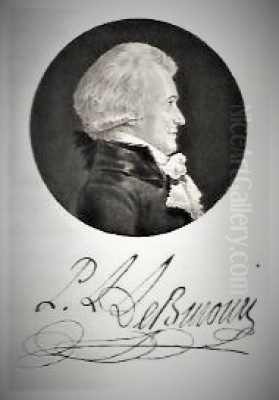
Philibert-Louis Debucourt stands as a significant figure in late 18th and early 19th-century French art. Born in Paris (or nearby Belleville, sources vary slightly on the exact location within the Paris environs) in 1755 and passing away in the same city in 1832, his life spanned a period of immense social and political upheaval in France. While initially trained as a painter, Debucourt found his true calling and lasting fame in the demanding medium of printmaking, particularly mastering the art of color aquatint. He became renowned for his elegant, detailed, and often subtly satirical depictions of Parisian society, fashion, and daily life, leaving behind a valuable visual record of his time.
Early Life and Academic Training
Debucourt's artistic journey began under the tutelage of Joseph-Marie Vien (1716-1809). Vien was a prominent painter and a key figure in the transition from Rococo to Neoclassicism, himself a teacher to the great Jacques-Louis David (1748-1825). Studying under Vien provided Debucourt with a solid academic foundation. Vien's own style, influenced by his time in Rome and his interest in classical antiquity, emphasized clarity, drawing, and moralistic themes, characteristics that were becoming increasingly fashionable.
Despite this Neoclassical training environment, Debucourt's early inclinations leaned towards genre painting – scenes of everyday life, often with a lighthearted or anecdotal quality. He gained recognition relatively early, becoming an approved member (agréé) of the prestigious Académie Royale de Peinture et de Sculpture in 1781. This status allowed him to exhibit his paintings at the official Salons, the epicenters of the Parisian art world. His acceptance piece was reportedly a rustic genre scene, indicating his initial focus.
In 1782, Debucourt married Marie-Madeleine-Claudine Mouchy, the daughter of the respected sculptor Jean-Baptiste Mouchy (1715-1791). This connection likely further integrated him into the artistic circles of Paris. His early Salon entries consisted primarily of paintings depicting genre subjects, often with a moralizing or sentimental tone popular at the time, sometimes drawing comparisons to the earlier Dutch masters or French painters like Jean-Baptiste Greuze (1725-1805), though Debucourt's touch was generally lighter.
The Turn to Printmaking
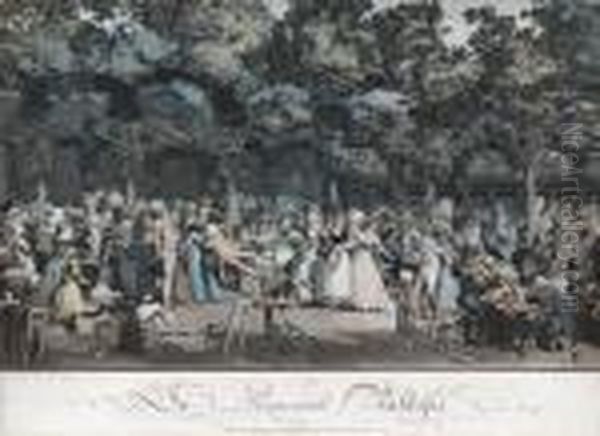
Around the mid-1780s, Debucourt made a pivotal shift in his career, moving away from painting as his primary focus and dedicating himself increasingly to the art of printmaking. This was not an uncommon path, as printmaking offered wider dissemination of images and potentially greater commercial viability. However, Debucourt was drawn specifically to the relatively new and complex techniques of color printing, particularly aquatint.
Aquatint, a process involving etching a copper plate through a porous ground of resin dust to create tonal areas, had been developed earlier in the century, notably by Jean-Baptiste Le Prince (1734-1781). When combined with etching for lines and printed in color using multiple plates (one for each color, inked à la poupée, or sometimes a combination), it allowed for subtle gradations of tone and wash-like effects that could mimic watercolors or gouache drawings.
Debucourt quickly demonstrated an exceptional talent for this demanding medium. He wasn't alone in exploring color printing; contemporaries like Charles-Melchior Descourtis (1753-1820) were also achieving remarkable results. However, Debucourt developed a particular finesse, achieving delicate color harmonies and intricate details that set his work apart. He often worked from his own designs but also interpreted the works of other artists, including popular contemporaries like Carle Vernet (1758-1836).
Master of Color Aquatint
Debucourt's technical mastery of color aquatint became his defining achievement. The process was laborious and required immense precision. Typically, a key plate would be etched with the main outlines of the composition. Then, separate plates would be prepared using the aquatint process, each designed to print a specific color (often blues, reds, yellows, and blacks or browns) in designated areas.
Achieving perfect registration – ensuring each plate printed exactly in the correct position relative to the others – was crucial and challenging. Debucourt excelled at this, layering translucent inks to create a wide range of hues and subtle tonal variations. His prints often possess a luminous, watercolor-like quality, far removed from the simple hand-coloring applied to many earlier prints.
His skill allowed him to capture the textures of fabrics, the play of light, and the nuances of facial expressions and gestures with remarkable fidelity. This technical brilliance was perfectly suited to his chosen subject matter: the elegant, ephemeral world of Parisian high society, with its emphasis on fashion, manners, and social display. His technique elevated the genre print to a new level of sophistication.
Chronicler of Parisian Society

Debucourt's most celebrated prints are those depicting the fashionable life of Paris during the late Ancien Régime, the Directory, and the Consulate. He captured the world of public promenades, private salons, domestic interiors, and the bustling arcades of the Palais Royal. His work offers a fascinating window into the customs, costumes, and social interactions of the era.
His scenes often echo the fêtes galantes pioneered by Jean-Antoine Watteau (1684-1721) earlier in the century, depicting elegant figures in leisurely pursuits. However, Debucourt's settings are distinctly contemporary and urban, rather than Watteau's idealized parklands. He observed his subjects with a keen eye, capturing the subtle codes of conduct, the flirtations, the social hierarchies, and the sheer spectacle of public life.
Unlike the stern Neoclassical history paintings of David, which focused on ancient virtue and republican ideals, Debucourt's art celebrated the pleasures and vanities of modern life. His figures are dressed in the height of fashion, their poses often elegant yet naturalistic. He depicted aristocrats, bourgeois families, soldiers, merchants, and even figures from the demimonde, creating a vibrant panorama of Parisian society.
Iconic Works: La Promenade Publique
Perhaps Debucourt's most famous and ambitious print is La Promenade Publique (The Public Promenade), published in 1792. This large, brilliantly colored aquatint depicts a fashionable crowd gathered in the gardens of the Palais Royal, which was then a center of social life, entertainment, and commerce in Paris.
The print is a masterpiece of composition and social observation. Debucourt skillfully arranges numerous figures in small groups across the scene, engaging in conversation, strolling, observing others, and displaying the latest fashions. The detail is exquisite, from the elaborate hats and dresses of the women to the tailored coats of the men. The use of color is particularly sophisticated, creating a sense of light, atmosphere, and vibrancy.
La Promenade Publique captures the specific social milieu of the Palais Royal, known for its mix of respectable society, political intrigue, gambling dens, and high-class prostitution. Debucourt subtly hints at these complexities, presenting a scene that is both elegant and slightly decadent. It stands as a quintessential image of Parisian life on the eve of the Reign of Terror, a world about to be irrevocably changed.
The Palais Royal and Other Social Scenes
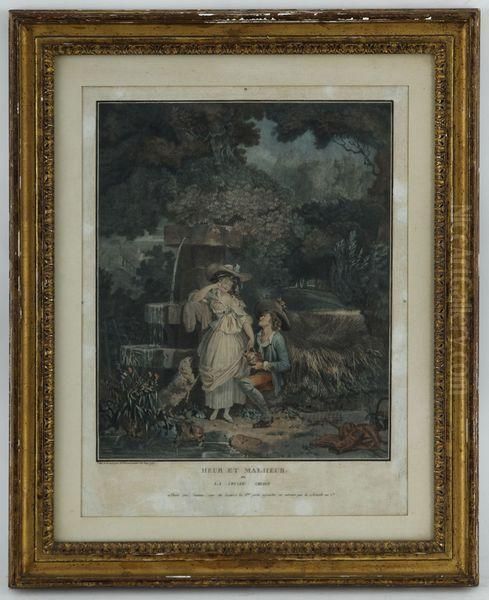
The Palais Royal features in other works by Debucourt, such as Promenade de la Galerie du Palais Royal (c. 1787), which depicts the covered arcades bustling with shoppers, strollers, and figures of varying social standing. These prints capture the unique atmosphere of this enclosed urban space, a microcosm of Parisian life.
He also produced pendants, pairs of prints designed to be viewed together, often contrasting different aspects of social life or stages of a narrative. Examples include L'Escalade or Les Adieux du Matin (The Escalade or The Morning Farewell) and its companion, depicting amorous encounters. These works often combined elegance with a gentle, sometimes risqué, humor.
His attention to detail extended to interior scenes as well. Prints like Le Menuet de la Mariée (The Bride's Minuet) and La Noce au Château (The Wedding at the Chateau) depict domestic celebrations and rituals, offering insights into family life and social customs among the well-to-do. These works showcase his ability to handle complex group compositions and render interior spaces and furnishings accurately.
Fashion and the Incroyables and Merveilleuses
Debucourt's prints are invaluable documents of fashion history. He meticulously recorded the changing styles of dress during a period of rapid transformation, particularly during the Directory (1795-1799). This era saw the emergence of the Incroyables (unbelievable men) and Merveilleuses (marvelous women), known for their extravagant and often eccentric styles of dress, reacting against the austerity of the Revolution.
His prints capture the high waistlines, sheer fabrics, and classically inspired silhouettes of women's fashion, as well as the tight breeches, elaborate cravats, and affected postures of the male dandies. Works like Les Modes et Manières du Jour (Fashions and Manners of the Day) series, although sometimes attributed to others working after his style, exemplify this focus. He also contributed illustrations to fashion journals, such as the influential Journal des Dames et des Modes.
His detailed rendering of clothing, hairstyles, and accessories provides crucial visual evidence for historians of fashion and material culture. He captured not just the garments themselves, but also how they were worn and the social attitudes they conveyed. His contemporary, Carle Vernet, also excelled in depicting fashionable figures and horses, and their works together offer a rich picture of the era's visual culture.
Navigating Revolution and Empire
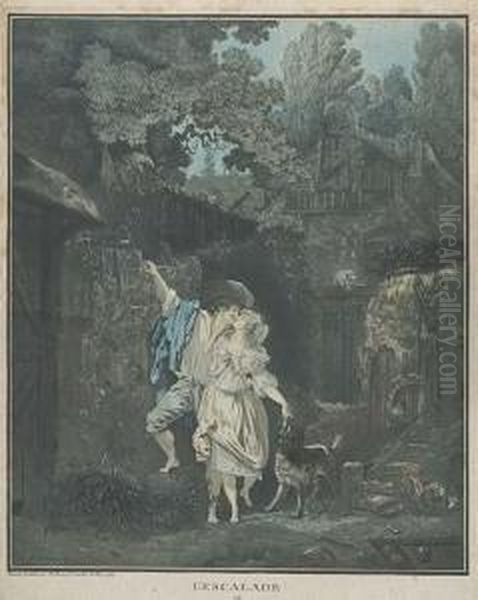
Living and working through the French Revolution, the Directory, the Consulate, and the Napoleonic Empire, Debucourt inevitably responded to the political and social changes around him. While not an overtly political artist in the mold of David, his work reflects the shifting tides of the era.
During the Revolution, he produced works like the Almanach National (National Almanac), also known as the Revolutionary Calendar, a complex allegorical print incorporating revolutionary symbolism and portraits of key figures. This demonstrates his engagement with the new political order, albeit perhaps more as a commercial necessity than deep ideological commitment.
Later, during the Bourbon Restoration after Napoleon's fall, he produced prints with royalist themes, such as Vive le Roi! (Long Live the King!). He also created equestrian portraits and scenes related to Napoleon, adapting his subject matter to suit the prevailing political climate and market demands. This adaptability allowed him to continue working successfully through successive regimes. His focus remained largely on social observation rather than grand political statements.
Satire and Social Commentary
While much of Debucourt's work celebrates elegance and fashion, a current of gentle satire often runs beneath the surface. His depictions of the Incroyables and Merveilleuses, for instance, border on caricature, highlighting the absurdity of their exaggerated fashions and affected manners.
He occasionally produced more overtly satirical prints, commenting on social follies or political situations. In this, his work sometimes approaches the spirit of his contemporary Louis-Léopold Boilly (1761-1845), who was a master of crowded Parisian street scenes and sharp social satire. While Debucourt's satire was generally milder and more refined than Boilly's, or certainly than the biting political caricatures of English artists like James Gillray (1756-1815) or Thomas Rowlandson (1757-1827), it adds another layer of interest to his work.
His observations on class distinctions, courtship rituals, and the pursuit of pleasure often contain a subtle critique or amused commentary on human vanity and social pretense. He presented a world obsessed with appearances, capturing it with both admiration and a hint of irony.
Family Life and Domestic Scenes
Beyond the public sphere of promenades and galleries, Debucourt also depicted scenes of private, domestic life. These prints often focus on family relationships, motherhood, and childhood, reflecting the growing emphasis on sentiment and domestic virtue in late 18th-century culture, influenced partly by the writings of philosophers like Jean-Jacques Rousseau.
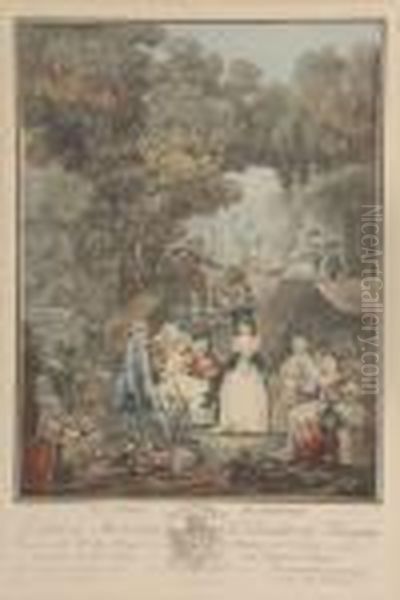
Works depicting mothers tending to their children, family gatherings, or quiet moments at home offer a contrast to his more bustling public scenes. These images often idealize family harmony and maternal affection, aligning with the bourgeois values that were gaining prominence. They show a different facet of Debucourt's art, one focused on intimacy and emotion rather than public display.
Compared to the profound intimacy and quiet dignity found in the domestic scenes of an earlier master like Jean-Baptiste-Siméon Chardin (1699-1779), Debucourt's approach is typically lighter and more narrative, often incorporating elements of contemporary fashion and interior design even within these private settings.
Contemporaries and Artistic Milieu
Debucourt operated within a vibrant and competitive Parisian art world. He exhibited alongside leading painters like Jacques-Louis David, Élisabeth Vigée Le Brun (1755-1842), Antoine Vestier (1740-1824), and miniaturists like Jean-Baptiste Isabey (1767-1855) at the Salons. While his chosen medium of printmaking set him somewhat apart from the painters vying for grand commissions, he was very much part of the artistic fabric of the city.
His technical innovations in color printing were part of a broader European interest in reproductive and color print techniques, with artists in England like Francesco Bartolozzi (1727-1815), known for stipple engraving, and Paul Sandby (1731-1809), an early adopter of aquatint, exploring similar avenues, albeit often with different stylistic results. In France, printers like Gilles Demarteau (1722-1776) had earlier perfected the crayon manner to imitate chalk drawings. Debucourt built upon these traditions, particularly the French advancements in multi-plate color printing pioneered by figures associated with Jacques Christophe Le Blon (1667-1741) and refined by artists like Jean-François Janinet (1752-1814).
His connection through marriage to the sculptor Jean-Baptiste Mouchy, and his training under Vien, placed him firmly within the established academic system, even as his primary output shifted to the more commercially oriented field of printmaking.
Later Career and Legacy
Debucourt continued to produce prints well into the 19th century, adapting his style and subject matter to changing tastes. Some critics feel his later work, particularly after the Napoleonic era, lacked the freshness and brilliance of his prints from the 1780s and 1790s. He increasingly undertook reproductive work, translating paintings by other artists, including Carle Vernet, into prints.
Despite this, his reputation as a master of color aquatint remained secure. His prints were sought after by collectors, and his influence could be seen in the work of later printmakers and illustrators. His meticulous depiction of costume also ensured his enduring value for fashion historians.

His legacy rests primarily on his remarkable achievements in color printmaking during the late 18th century. He pushed the technical boundaries of aquatint, creating images of exceptional beauty, detail, and chromatic subtlety. Furthermore, his work provides an unparalleled visual record of Parisian society during a pivotal moment in French history, capturing the elegance, anxieties, and transformations of his time with wit and artistry.
Market Reception and Collections
Throughout his career and afterward, Debucourt's prints found a market among collectors who appreciated their technical skill and charming subject matter. Auction records, such as those mentioned from a 2006 sale at Drouot in Paris, show his works continue to be traded, with prices varying depending on the rarity, condition, and subject of the print. His most famous works, like La Promenade Publique, were recognized as significant achievements even in his own time.
However, some assessments suggest that while respected, he may not have achieved the same level of widespread fame or financial success as some of the leading painters of his day. The number of his original drawings known today is relatively small compared to his print output, and much of his later work involved reproducing others' designs.
Nevertheless, his importance is confirmed by the presence of his works in major international museum collections. Institutions such as the National Gallery of Art in Washington D.C., the Musée du Louvre in Paris, the Victoria and Albert Museum in London, and the Metropolitan Museum of Art in New York hold significant collections of his prints, ensuring their accessibility for study and appreciation. His work is frequently included in exhibitions focusing on French printmaking, fashion history, or the art of the Revolutionary and Napoleonic eras. While no major dedicated retrospectives seem to have occurred recently or are planned, his place in art history is secure.
Conclusion
Philibert-Louis Debucourt was more than just a skilled craftsman; he was an astute observer and a sensitive interpreter of his time. Through the demanding medium of color aquatint, he captured the fleeting moments of Parisian life with unparalleled elegance and technical brilliance. His prints transport us to the world of powdered wigs and revolutionary fervor, of Directory dandies and Empire gowns, offering a window onto the surfaces and perhaps the soul of a society in flux. As a master technician who pushed the boundaries of color printing and as a visual historian of Parisian manners and modes, Debucourt holds a unique and enduring place in the annals of French art. His delicate, colorful images remain a testament to his artistry and a precious record of a bygone era.